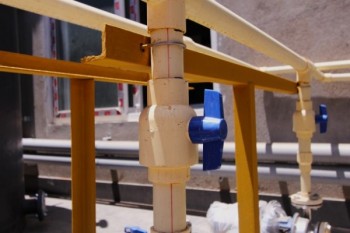Potable Water Line Restoration
NSF/ANSI 61 Certified, US Pipelining has trenchless and non-invasive potable waterline restoration and rehabilitation methods for all forms of potable water pipes ranging in size from 1-inch to 72-inches in diameter.
How Potable Waterline Restoration and Rehabilitation Works...
The systems of pipes that transport water from the source (such as a treatment plant) to the customer are often categorized from largest to smallest as transmission or trunk mains, distribution mains, service lines, and premise plumbing. Transmission or trunk mains usually convey large amounts of water over long distances such as from a treatment facility to a storage tank within the distribution system.
Distribution mains are typically smaller in diameter than the transmission mains and generally follow the city streets. Service lines carry water from the distribution main to the building or property being served. Service lines can be of any size depending on how much water is required to serve a particular customer and are sized so that the utility’s design pressure is maintained at the customer’s property for the desired flows. Premise plumbing refers to the piping within a building or home that distributes water to the point of use. In premise plumbing the pipe diameters are usually comparatively small, leading to a greater surface-to-volume ratio than in other distribution system pipes.
When systems begin to age failures, cracks, leaks occur within the lines. The US Pipelining restoration system is a cured-in-place pipe (CIPP) technology specifically engineered for pressure pipelines and certified to NSF/ANSI 61 standards.
The US Pipelining system not only provides a structural renovation of the host pipe, it also offers the additional benefits of protecting the host pipe from internal corrosion, sediment build-up or further tuberculation. It often improves the hydraulic flow capacity compared with the existing host pipe.
With a 50-year design life, The US Pipelining CIPP system is designed to meet the AWWA Class IV lining system as a fully structural liner independent of the host pipe and meet ASTM F1216 guidelines. In addition, the US Pipelining CIPP system may be used for partially deteriorated pipelines as a Class III lining system relying on the host pipe. This would be considered a semi-structural liner. The US Pipelining CIPP system possesses a long-term internal pressure rating of up to 150 psi. With these design characteristics, US Pipelining CIPP can be considered equivalent to replacing the existing infrastructure with a new pipe without the disruption and costs of traditional dig and replace methods.
Are you in need of potable waterline repair and restoration services? Contact US Pipelining today to learn more about our NSF/ANSI 61 Certified structural restoration lining methods for potable water applications.
